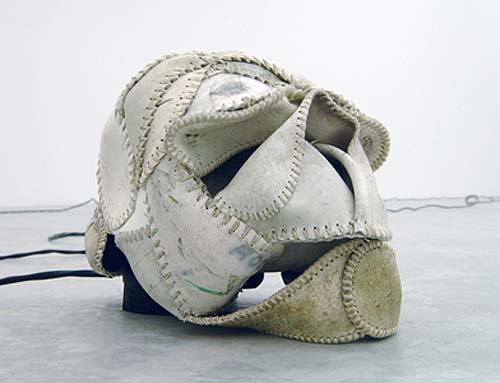19/5/2006
Brian Jungen
Tate Modern, London
An red flag constructed from an assortment of mass-produced materials: bags, hats, clothes, small plastic kitchen tools, umbrellas and other things are stitched together into a patchwork quilt. Working with consumer goods, Jungen's sculptural forms examine the subjects of anthropology, art history and consumerism, often linking his Canadian Indian heritage to questions of cultural identity and economy.

Canadian artist, Brian Jungen (b 1970), will create a new work specifically for the Level 2 Gallery at Tate Modern, to be unveiled on 20 May. Having gained an international reputation as one of Canada’s foremost contemporary artists, this will be Brian Jungen’s first exhibition in the UK.
Jungen’s piece will be a massive red flag constructed out of an assortment of mass produced materials. Bags, hats, clothes, small plastic kitchen tools and umbrellas will be brought together to form the huge quilt-like work. Inspired in part by Jungen’s interest in the Greenpeace movement and, in particular, the banners made by the members of this group which began in Jungen’s hometown Vancouver, the colour and form of Jungen’s flag is also a reference to the poem by Jim Connell, The Red Flag. Connell was an Irish political activist of the late nineteenth and early twentieth century, best known as the writer of this 1889 anthem.
The Red Flag
The people's flag is deepest red,
It shrouded oft our martyred dead,
And ere their limbs grew stiff and cold,
Their hearts blood dyed its every fold.
(chorus)
Then raise the scarlet standard high.
Within its shade we'll live and die,
Though cowards flinch and traitors sneer,
We'll keep the red flag flying here.
Look round, the Frenchman loves its blaze,
The sturdy German chants its praise,
In Moscow's vaults its hymns are sung
Chicago swells the surging throng.
It waved above our infant might,
When all ahead seemed dark as night;
It witnessed many a deed and vow,
We must not change its colour now.
It well recalls the triumphs past,
It gives the hope of peace at last;
The banner bright, the symbol plain,
Of human right and human gain.
It suits today the weak and base,
Whose minds are fixed on pelf and place
To cringe before the rich man's frown,
And haul the sacred emblem down.
With heads uncovered swear we all
To bear it onward till we fall;
Come dungeons dark or gallows grim,
This song shall be our parting hymn.
Jim Connell (1889)
Working with consumer goods, Jungen’s sculptural forms examine the subjects of anthropology, art history and consumerism, often linking his Canadian Indian heritage to questions of cultural identity and the global economy. His work is characterised by an inventive use of materials combined with meticulous craftsmanship. Through the transformation of everyday objects into symbolic sculptures and installations, Jungen creates thought-provoking aesthetic pieces which challenge their original function. For example, in his recent work Prototype for New Understanding Series (1998-2005), the artist cut apart Nike Air Jordan trainers and reassembled them to create twenty-three imitations of Northwest Coast Canadian Indian masks. By combining recognisable branded footwear and sacred First Nation’s artwork, the artist addresses the disintegratation of cultural identification into forms of brand recognition.
In Jungen’s renowned works, Shapeshifter (2000), Cetology (2002) and Vienna (2003), the artist created large, whale-skeleton sculptures from plastic garden chairs. By adopting chairs as his material, Jungen’s whale sculptures appear both as objects of natural history and also the product of consumer culture.
Jungen is part of a younger generation of artists who have emerged over the last few years amid an active scene in Vancouver, Canada. He was born in Fort St John, British Columbia to a Canadian Indian mother and a Swiss-Canadian father. This dual heritage, and the tensions and links between aboriginal traditions, pop culture and consumerism, often provide the themes and subject matter for his work. Jungen moved to Vancouver and graduated from the Emily Carr Institute of Art and Design in 1992. In 2002, he was awarded the inaugural Sobey Art Award, the foremost prize in Canada for emerging artists under the age of forty in recognition of outstanding achievement. He has had recent solo exhibitions at the Vancouver Art Gallery and at Casey Kaplan Gallery in New York.
This exhibition by Brian Jungen is the fifth in the Level 2 Gallery Series, and is curated by Jessica Morgan, Curator, Contemporary Art, Tate Modern, assisted by Amy Dickson, Assistant Curator, Tate Modern. Conceived by Jessica Morgan, the Level 2 Gallery Series presents new or recent work by international artists in a specially created exhibition space at Tate Modern. The sixth exhibition in this series will be by Roman Ondak from 29 July until 17 September.
Tate Modern Level 2 Gallery
Bankside - London
Free Admission



